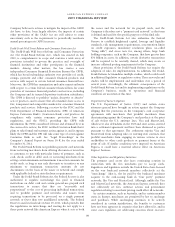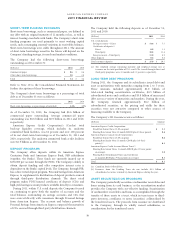American Express 2011 Annual Report Download - page 27
Download and view the complete annual report
Please find page 27 of the 2011 American Express annual report below. You can navigate through the pages in the report by either clicking on the pages listed below, or by using the keyword search tool below to find specific information within the annual report.AMERICAN EXPRESS COMPANY
2011 FINANCIAL REVIEW
Income Taxes
The effective tax rate was 30 percent in 2011 compared to 32
percent in 2010 and 25 percent in 2009. The tax rates in all years
reflect the level of pretax income in relation to a generally
consistent level of recurring permanent tax benefits. In addition,
the tax rate in 2011 reflects a benefit related to a distribution of
foreign subsidiary earnings with associated tax credits, as well as
the favorable resolution of certain prior years’ tax items.
CASH FLOWS
Cash Flows from Operating Activities
Cash flows from operating activities primarily include net
income adjusted for (i) non-cash items included in net income,
including the provision for losses, depreciation and
amortization, deferred taxes, and stock-based compensation and
(ii) changes in the balances of operating assets and liabilities,
which can vary significantly in the normal course of business due
to the amount and timing of various payments.
For the year ended December 31, 2011, net cash provided by
operating activities of $10.5 billion increased $1.6 billion
compared to $8.9 billion in 2010. The increase was primarily due
to higher net income in 2011 and increases in other receivables
and accounts payable and other liabilities, partially offset by
lower provisions for losses and decreases in deferred taxes and
other in 2011.
For the year ended December 31, 2010, net cash provided by
operating activities of $8.9 billion increased $2.6 billion
compared to $6.3 billion in 2009. The increase was primarily due
to higher net income in 2010, increases in non-cash expenses for
deferred taxes, acquisition costs and increases in accounts
payable and other liabilities in 2010, partially offset by lower
provisions for losses and an increase in other assets in 2010.
Cash Flows from Investing Activities
The Company’s investing activities primarily include funding
cardmember loans and receivables, securitizations of
cardmember loans and receivables, and activity in the
Company’s available-for-sale investment portfolio.
For the year ended December 31, 2011, net cash used in
investing activities of $0.5 billion decreased $0.7 billion
compared to net cash used in investing activities of $1.2 billion
in 2010, primarily due to lower purchases of investments and a
decrease in restricted cash, partially offset by lower sales,
maturity and redemption of investments and increases in
cardmember loans and receivables.
For the year ended December 31, 2010, net cash used in
investing activities of $1.2 billion decreased $5.6 billion
compared to net cash used in investing activities of $6.8 billion
in 2009, primarily due to higher maturity and redemption of
investments and lower purchases of investments, partially offset
by increases in cardmember loans and receivables.
Cash Flows from Financing Activities
The Company’s financing activities primarily include issuing and
repaying debt, taking customer deposits, paying dividends and
repurchasing common and preferred shares.
For the year ended December 31, 2011, net cash used in
financing activities of $1.4 billion decreased $6.7 billion
compared to $8.1 billion in 2010, due to increases in customer
deposits and issuances of long-term debt during 2011 as
compared to 2010, partially offset by increases in principal
payments of long-term debt and repurchases of common shares
and a decrease in short-term borrowings in 2011.
For the year ended December 31, 2010, net cash used in
financing activities of $8.1 billion increased $3.5 billion
compared to $4.6 billion in 2009, due to a reduced level of
growth in customer deposits during 2010 as compared to 2009
and an increase in principal payments of long-term debt,
partially offset by a net increase in short-term borrowings in
2010 and the repurchase of preferred shares in 2009.
CERTAIN LEGISLATIVE, REGULATORY AND OTHER
DEVELOPMENTS
As a participant in the financial services industry, the Company
is subject to a wide array of regulations applicable to its
businesses. As a bank holding company and a financial holding
company, the Company is subject to comprehensive examination
and supervision by the Federal Reserve and to a range of laws
and regulations that impact the business and operations. In
addition, the extreme disruptions in global capital markets that
commenced in mid-2007 and the resulting instability and failure
and near failure of numerous financial institutions, as well as
reports of widespread consumer abuse, led to a number of
changes in the financial services industry, including more intense
supervision, enhanced enforcement activity, significant
additional regulation and the formation of additional regulatory
bodies. Although the long-term impact on the Company of
much of the recent and pending legislative and regulatory
initiatives remains uncertain, the Company expects that
compliance requirements and expenditures will continue to rise
for financial services firms, including the Company, as the
legislation and rules continue to become effective and
implemented over the course of the next several years.
The CARD Act
The Company is subject to the provisions of the legislation
known as the CARD Act, which was enacted in May 2009 to
fundamentally reform credit card billing practices, pricing and
disclosure requirements. The Company has made changes to its
product terms and practices that are designed to comply with the
CARD Act, including pricing-related actions, while mitigating
the impact on Company revenue of the changes required by the
CARD Act and the regulatory amendments. Although the
25
























